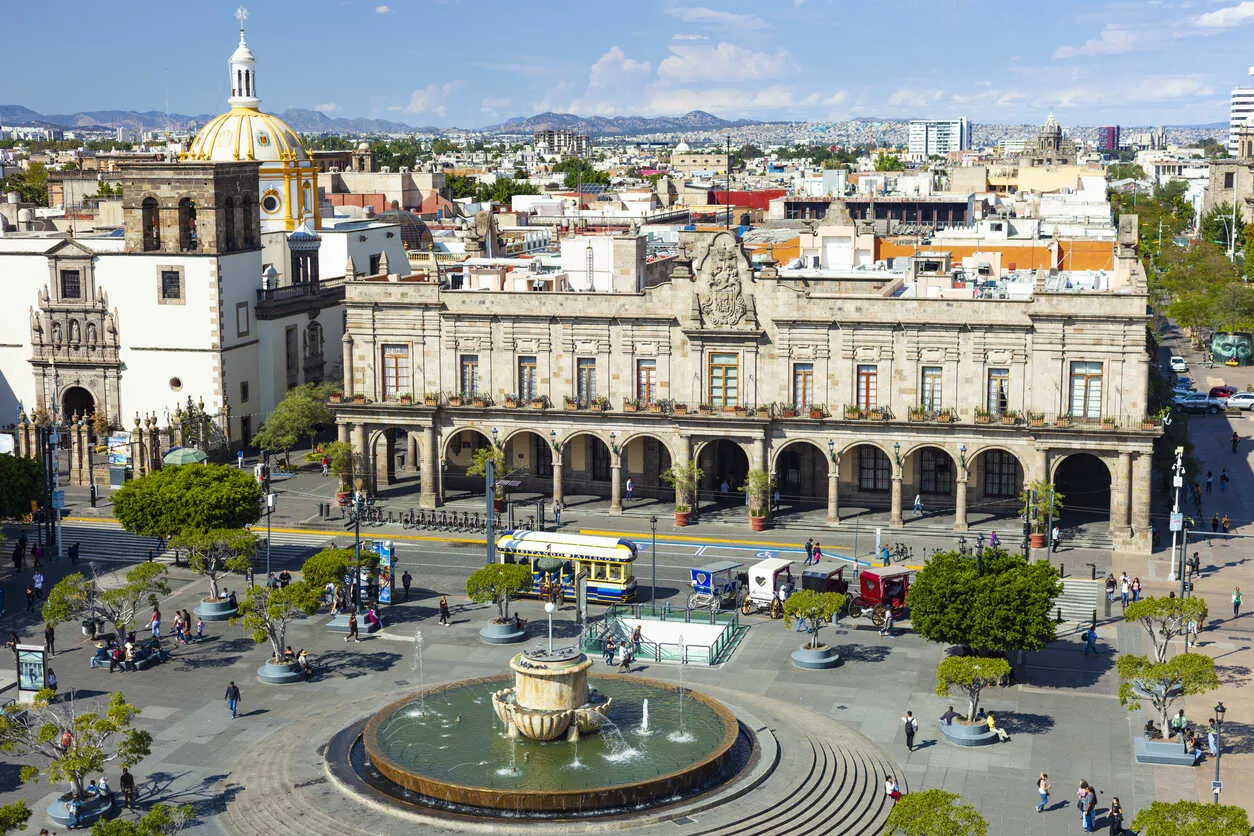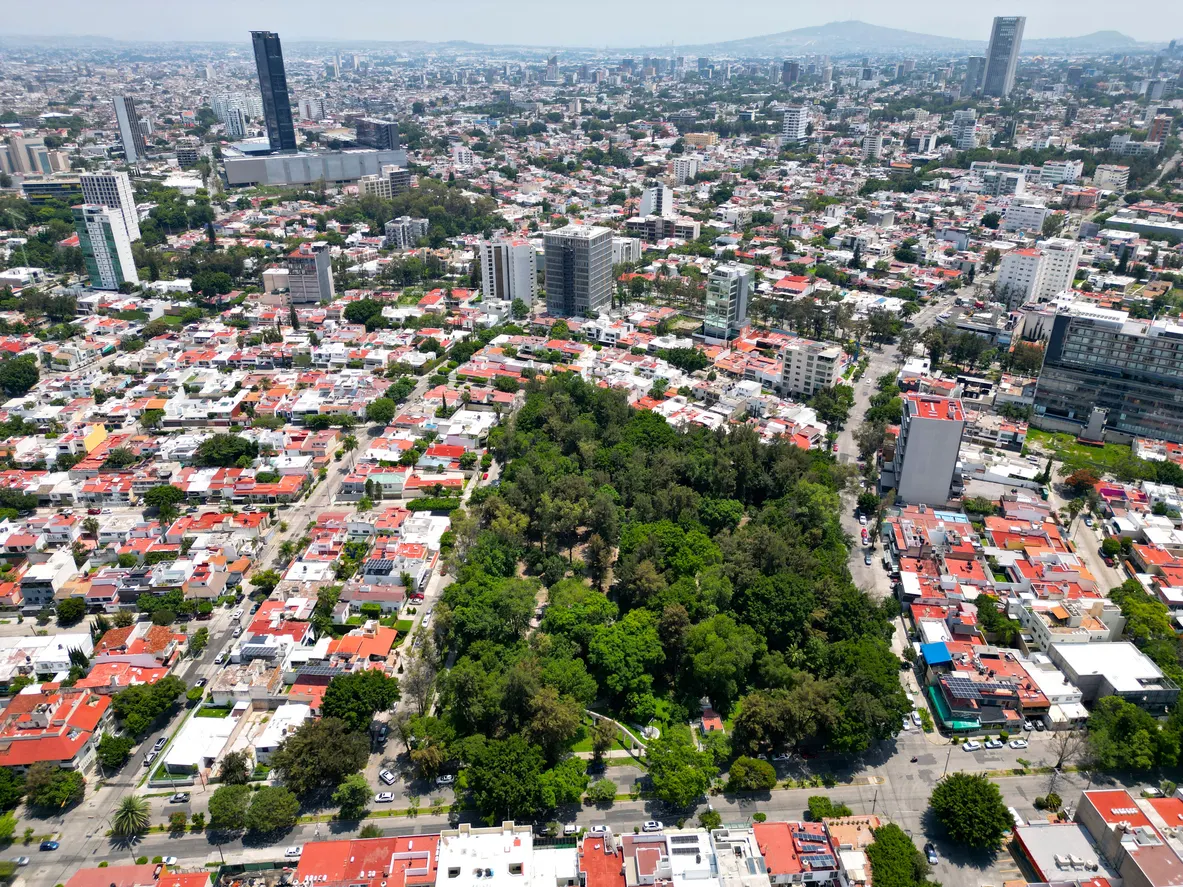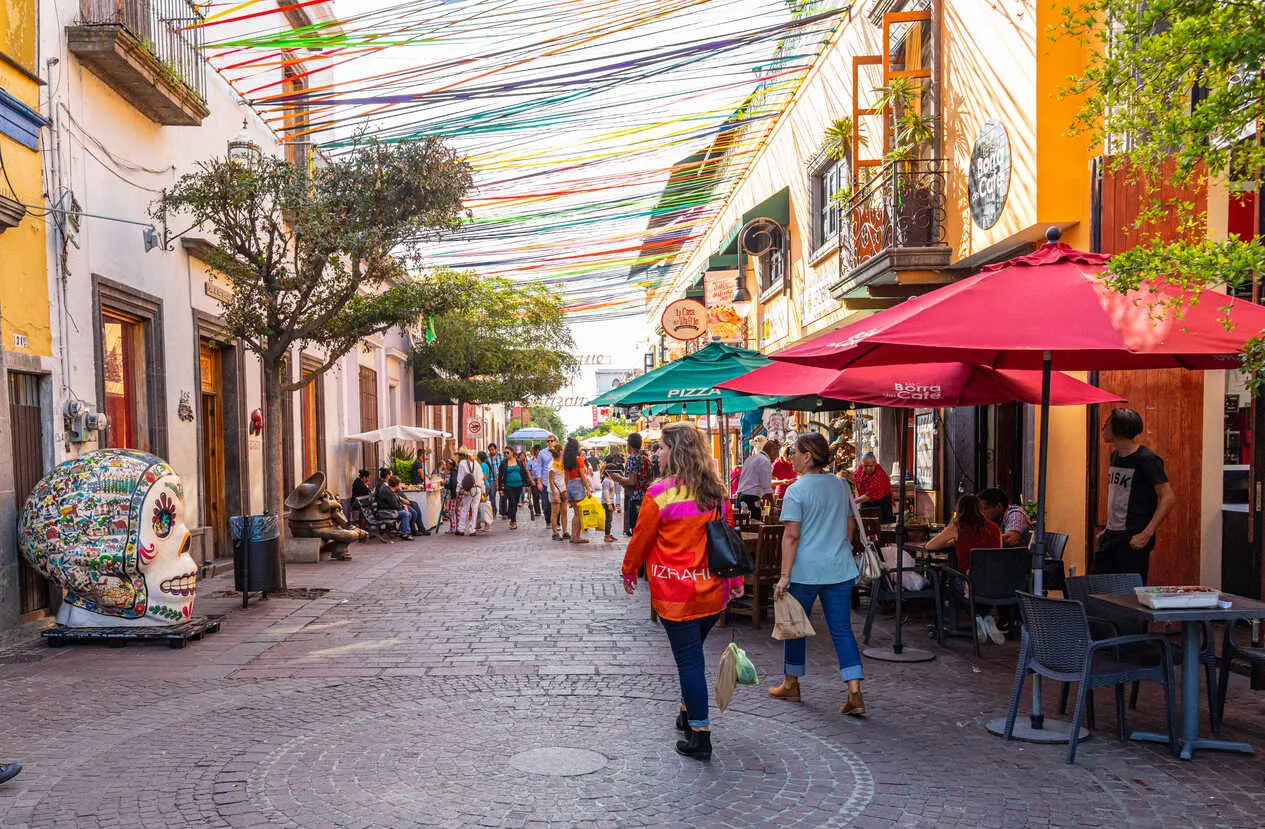Guadalajara is the land of Mariachis, Tequila, and a rich cultural heritage. It’s also the capital of the Mexican state of Jalisco and a thriving tech hub known as Mexico’s Silicon Valley. This blend of history and modernity offers something for everyone, including all types of neighborhoods, or colonias as they’re called in Mexico.
It draws expats from around the world thanks to its mix of culture, temperate climate, and affordable cost of living. The result is a city with international schools and a vibrant social scene, including monthly foodie meetups to explore its delicious restaurant offerings.
It’s also the second-largest city in Mexico, with a population of a little more than 5 million. Yet, despite that urban density, many parts of the city have low-rise buildings and plenty of greenery, giving many of the city’s colonias more of a leafy, older neighborhood feel than a big-city modern vibe. Contemporary high-rises do exist if that’s what you crave.
Deciding where to lay your head at night can be challenging in a big city. It’s a good idea to book a few nights in a hotel or vacation rental first to get a lay of the land before committing to something long-term. That flexibility gives you the chance to explore the different colonias and get a sense of their unique characteristics. You might then choose a more extended stay in the popular bohemian student district, upscale Providencia, or head beyond the central neighborhoods.
Whichever you choose, you’re sure to be charmed by the city’s vibrant greenery and Tapatíos (people from Guadalajara).
How To Move Out of the U.S.
How To Move Out of the U.S.
The policy implications of the last election impacted your retirement funds, taxes, healthcare, and more. But you can protect yourself, your family, your future. In lots of safe, warm, friendly spots abroad, you can live comfortably on a budget from $2,000-$3,800 a month (all-in—housing and extras included). We’ll show you how—and where—to go.

By submitting your email address, you will receive a free subscription to IL Postcards, Overseas Dream Home, The Untourist Daily and special offers from International Living and our affiliates. You can unsubscribe at any time, and we encourage you to read more about our Privacy Policy.
Top Guadalajara Neighborhoods for Expats
While the city sprawls across approximately 100 square miles, each neighborhood feels like a mini-city, and many of them are green oases.
Guadalajara’s nickname is the “City of Roses.” Legend has it that this name dates back to the 1800s during Mexico’s War of Independence, when hundreds of roses unfurled and blocked the path of royal soldiers pursuing the Resistance fighters. Today, you’ll find roses, bougainvillea, and majestic royal palms mixed with cacti throughout the city.
Centro Histórico

If you’re just popping by Guadalajara for a few days for a dose of history, this is the area to stay. Clean, wide sidewalks and tree-lined plazas connect some of the city’s most iconic historic destinations.
The Historic Center, or Centro Histórico, draws thousands of tourists every year to see the cathedral completed in 1618, the 300-year-old Hospicio Cabañas (a UNESCO World Heritage Site), or a performance at the 1866 Teatro Degollado.
You can easily spend a day or two taking in the historic sites and outdoor art, and grab a bite at the Mercado San Juan de Dios, the largest indoor market in Latin America. You can also participate in other tourist adventures, like riding in a horse-drawn, European-style carriage.
Like many capital city downtown areas, it’s primarily businesses, government buildings, hotels, and restaurants. It’s a great area to park yourself in for a few days and take in the sights, but there’s not as much housing stock here as in other parts of town. Transportation is easy, with buses, a subway, Uber, and taxis ready to take you wherever you want to go.
Colonial Americana
Time Out Magazine called Colonial Americana “the coolest neighborhood in the world” in 2022. Sure, it’s home to a campus of The University of Guadalajara and the Museo de las Artes Universidad de Guadalajara (MUSA), but its vibrancy extends beyond the plentiful students in the area.
Innovation is a cornerstone of the neighborhood. First developed in the early 1900s as a wealthy district of mansions, architects used it as a “testing ground” of sorts. They studied European trends and experimented with new materials and styles. The result is stunning Art Deco and Neoclassical mansions sitting alongside modern buildings on tree-lined streets.
This colonia also serves as a creative hub for today’s entrepreneurial scene. You’re as likely to find new tech start-ups here as a hipster coffee shop or a walking tour of artist workspaces.
Speaking of artists, there’s plenty of street art here as well as the art found in MUSA. Murals can be seen on nearly every block, and vibey restaurants and cafes are scattered throughout the district. Then there’s Avenida Chapultepec—a street packed with bars, clubs, and restaurants. It’s a city-wide destination for nightlife, especially on weekends. It’s so popular that its name has even inspired a chain of low-priced, pub-style restaurants across Mexico, where everything is just twenty-five pesos.
Nearby, there’s a famous fountain with a statue of Minerva (also known as Athena) rising. She symbolizes the city’s strength, and when Guadalajara’s soccer teams win, or there’s a parade, it becomes a popular gathering spot. But Americana isn’t all about nightlife. The area also offers parks and designated bike lanes for those who enjoy sunshine and exercise.
Colonia Ladron de Guevara
Americana spills into this quiet residential neighborhood. Thanks to its proximity to the university, many students live here, and Market Data Mexico estimates the population to be around 20,000 people, most of whom are under 40 years old.
This walkable neighborhood features a mix of restored older homes and newer buildings, as well as schools, coffee shops, bookstores, grocery stores, and restaurants. It’s close enough to walk to Chapultepec’s nightlife but far enough away to enjoy a quieter atmosphere. Centrally located and affordable for many, it attracts students, artists, and young families.
Providencia

Providencia is one of the city’s most affluent neighborhoods, popular with families and professionals. Developed in the mid-1900s, its mature trees and elegant homes evoke the charm of New Orleans’ Garden District.
Providencia’s tree-lined streets lead to gourmet dining and upscale shopping. The neighborhood borders the city’s financial district on Avenida de las Americas and is close to Bosque Los Colomos. This beautiful park features Japanese gardens, jogging paths, and horse trails, making it a lovely way to while away an afternoon.
Providencia even has its own aqueduct—the Acueducto de Guadalajara, built in 1900 to channel water from one part of the city to another.
Santa Tere
Short for Santa Teresa, this traditionally tradesperson neighborhood takes its name from the area’s Church of Santa Teresita. The area bustles with business, including a popular market, the Mercado Santa Tere, where you can buy local foods like fruits, vegetables, meats, and seafood. Shop while nibbling on birria tacos—a local favorite traditionally made as a goat stew. The taco version features succulent meat in soft corn tortillas spritzed with lime and sprinkled with chopped onions and cilantro.
Because of its long history as a working-class neighborhood, Santa Tere’s architecture consists more of functional concrete buildings than restored mansions. Yet, it offers a rich history in other ways.
Some of Guadalajara’s most famous artists lived in Santa Tere, including José Clemente Orozco, who painted the murals in the Hospicio Cabañas, and prominent academic and writer Marco Aurelio Larios, who taught literature at the nearby university.
Get Your Free Mexico Report Today!
Get Your Free Mexico Report Today!
Learn more about Mexico and other countries in our daily postcard e-letter. Simply enter your email address below and we’ll send you a free special report – Mexico: The Perfect Close-to-Home Retirement Haven.

By submitting your email address, you will receive a free subscription to IL Postcards, Overseas Dream Home, The Untourist Daily and special offers from International Living and our affiliates. You can unsubscribe at any time, and we encourage you to read more about our Privacy Policy.
Chapilita
This neighborhood was originally a ranch in the early 20th century and was subdivided in the 1940s, continuing the “garden city” concept so popular in Guadalajara.
However, unlike many suburbs in the United States, this is a mixed-use neighborhood that prioritizes green spaces and walkability. It is popular with families and features numerous Art Deco and Modernist buildings.
Fun fact: Mexico’s most famous architect, Luis Barragán, designed a striking mid-century modern building in this neighborhood. It’s still used as commercial property today. There’s also a Sunday art market in the Glorieta Chapalita park. Colonia Chapilita straddles Guadalajara and neighboring Zapopan.
Zapopan
Technically, Zapopan is a separate municipality, but it has been swallowed up by Guadalajara’s urban sprawl and isn’t just one neighborhood but many. It’s about an hour’s drive from the central neighborhoods. However, it’s worth mentioning because it’s a popular place to live.
Zapopan has its own historic district featuring the 17th-century Basilica de Zapopan, a stunning Baroque church. There’s an annual pilgrimage each October to honor Our Lady of Zapopan, recognized as an Intangible Cultural Heritage by UNESCO. According to a government website, the pilgrimage spans 9 kilometers, involves 30,000 dancers, and attracts two million pilgrims.
Beyond its historical significance, the area boasts multiple parks, a contemporary art museum, two prestigious universities, and even an innovation center, Ciudad Creativa Digital. For upscale shopping, there’s the Andares Mall, a destination for people within 200 miles, surrounded by modern skyscrapers.
One historic neighborhood within Zapopan is El Seattle, where wealthy Tapatíos built country houses nearly 100 years ago. Today, you’ll find a mix of historic homes, modern residences, apartment buildings, and the Villa Fantasía, a children’s playground perfect for keeping the little ones busy. Combine that with the Trompo Mágico Children’s Museum, and it’s clear this is a family-focused area.
Tlaquepaque

If Zapopan is on one side of Guadalajara, Tlaquepaque, pronounced [Tlah-keh-PAH-keh], is on the other, roughly an hour and a half away by car due to city traffic. Like Zapopan, Tlaquepaque is a separate municipality, but as Guadalajara has grown, the boundaries have blurred, and it feels like another neighborhood. Tlaquepaque is famed for its indigenous ceramics, vibrant restaurant scene, and charming small-town feel.
Designated a Pueblo Mágico, hundreds of visitors stroll the cobblestoned pedestrian street of Calle Independencia, exploring its shops and art galleries on weekends. The surrounding area remains rich with craftspeople, and if you wander further from the center, you might find an artist putting the finishing touches on a piece of Talavera pottery.
Calle Independencia offers several excellent restaurants and fantastic people-watching opportunities. There’s gourmet dining at Casa Luna (the best steak we’ve had in Mexico!). For a memorable mariachi experience, every Friday afternoon, the all-female mariachi group Flor de Agave enchants diners at El Patio.
Wander down Calle Independencia a few blocks, and it opens onto the Jardín Hidalgo, a plaza with two churches, benches, and a bandshell for performances. It’s a favorite gathering spot for locals and tourists alike.
Getting There
Getting to Guadalajara is straightforward. Located in northwestern central Mexico, it’s roughly seven hours by bus from Mexico City. The ETN bus line provides a remarkably comfortable journey, with reclining seats, Wi-Fi, and in-seat entertainment, all for about $50 USD.
For other nearby destinations, a new toll road cuts the trip to Puerto Vallarta down to just 3.5 hours. Guadalajara is also 1,020 miles (1,642 kilometers) from Nogales, Arizona, making it accessible for cross-border travelers.
Final Thoughts
Guadalajara is a vibrant, walkable city filled with diverse colonias. Whether you’re drawn to the tree-lined, lively Americana; the suburban charm of Chapilita; or the convenience of a downtown high-rise, the city offers something for every taste and lifestyle. Wherever you choose to explore, you’re sure to find fascinating new adventures in this dynamic and culturally rich metropolis.
Get Your Free Mexico Report Today!
Get Your Free Mexico Report Today!
Learn more about Mexico and other countries in our daily postcard e-letter. Simply enter your email address below and we’ll send you a free special report – Mexico: The Perfect Close-to-Home Retirement Haven.

By submitting your email address, you will receive a free subscription to IL Postcards, Overseas Dream Home, The Untourist Daily and special offers from International Living and our affiliates. You can unsubscribe at any time, and we encourage you to read more about our Privacy Policy.
